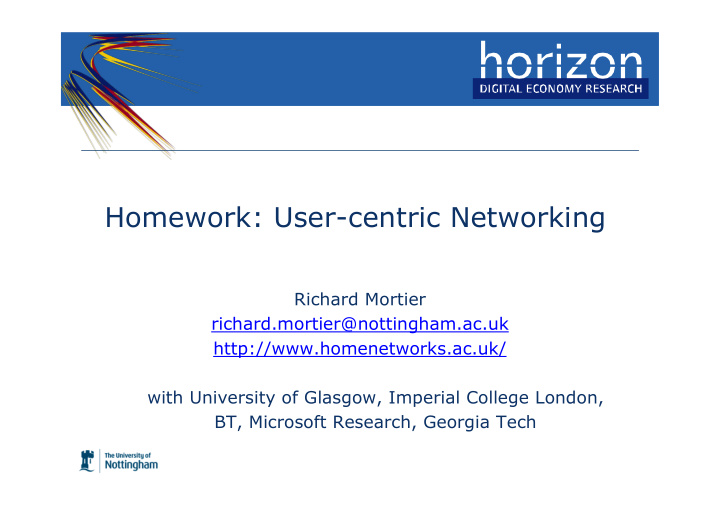



Homework: User-centric Networking Richard Mortier richard.mortier@nottingham.ac.uk http://www.homenetworks.ac.uk/ with University of Glasgow, Imperial College London, BT, Microsoft Research, Georgia Tech
Acknowledgements • A three year project funded by EPSRC and RCUK • Project partners as well as University of Nottingham: – University of Glasgow, Imperial College London – BT, Microsoft Research – Georgia Tech • Ethnography and technology deployment to 24+ households • Part of a wider agenda concerned with the redesign of (technology) infrastructure for use in domestic contexts 2 2
Why Homework? 300 million 300 million people people Home networking Home networking worldwide worldwide gear is the most the most gear is have have returned consumer consumer returned broadband broadband electronics item item electronics connections to connections to stores (25%) stores (25%) the Internet Internet the Consumers cite Consumers cite 51% of UK 51% of UK technical technical households households complexity as complexity as now have a now have a the largest the largest broadband broadband barrier to home barrier to home connection connection networking networking 3 3
4 4
Lived reality is messy and complex
Usage spans layers Layer Intent/purpose Example Multiplexing of traffic User Everyday living Relax for an hour Impact/Dependency Use Particular task or activity Watch a TV show Application Provide service to user(s)/other YouTube (software) apps. Application Standardised application-class HTTP (for WWW), FTP, (protocol) communication SSH, DNS, … Transport Generic data transport TCP (e.g., reliable, large) Network Communicate globally Internet Protocol (IP) Link Communicate over direct Wireless Ethernet (802.11) connections Physical Get signal from A to B 802.11b PHY 6 6
The Infrastructure Challenge (1) • Monitoring consumption – Mechanisms to capture usage information at an appropriate level of abstraction – Techniques to make measured traffic more readily available to the user • Performance and activity – Mechanisms to allow real time flow monitoring and alert users of these issues as they occur 7 7
The Infrastructure Challenge (2) • Prioritization – Mechanisms to prioritize and control traffic associated with different devices and activities in real time – Human situated judgment is essential and users need to be linked to these mechanisms • Policing the network – Lightweight mechanisms to manage how people get on and off a network, and what exactly they may or may not do when on the network 8 8
9 9
Interaction in the Infrastructure • Putting people in the protocol by embedding user interaction in existing infrastructure protocols – Amending DHCP to involve the user in granting leases • Bringing services closer to users by allowing greater control and configuration – Running a local DNS service that can access greater contextual information • Exploiting the physical arrangement of the home by manifesting the infrastructure in the home – Using physical plug in tokens (USB keys) to manage access to the infrastructure and encode permissions 10 10
People in the Protocol 11 11
Controlling Localised Service 12 12
Contention Monitor 13 13
Physical Displays 14 14
15 15
Fundamental Challenges • Home networks have become mundane – Another channel through which everyday life happens – Really no longer special • But the (software) technology has not made this leap! – Still managed in terms of protocols and services – Shopping , not the web , not HTTP – The user doesn’t draw a distinction between service (name resolution) and the network (IP forwarding) • To do better we need the enabling technologies to allow these top-to-bottom connections to be made – Making the network intelligible ( not intelligent) 16 16
Reflecting Broadly • Designing to meet these challenges needs multiple skillsets – Ethnography, HCI, Systems, Networking, … • This requires greater dialogue between communities – Just throwing results over the fence doesn’t work – Engineers must know about ethnography (a bit) – Ethnographers must know about technology (a bit) • Else we will continue to make useless things – By imposing ridiculous demands, or – By implementing unusable/inappropriate technology 17 17
Questions? 18 18
Recommend
More recommend